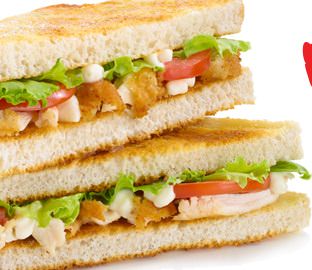Sandwich
sandwich is a food consisting of one or more different types of food, such as sliced cheese or meat, vegetables, placed on or between one or more slices of sandwich bread /s.
A #sandwich is a perfect balance of –

- Temperature – HOT OR COLD
- Texture- CRUNCHY, CHEWY, SMOOTH, WET , DRY
- Flavor- INTEGRITY OF VARIOUS COMPONENTS
- Appearance- SIMPLE AND CORRECT
Parts of Sandwich:
- Bread: Various types of bread are used for sandwich.
- a) Pullman or sandwich loaf of white bread is the most popular because of its neutral flavor.
- b) Rills -including hard and soft rolls, hamburger and hot dog rolls and long rolls for ‘submarine’ sandwich.
- c) French bread-slit horizontally.
- d) Whole wheat bread
- e) Rye bread or pumpernickel
- f) Pita (or unleavened) bread
- g) Raisin, fruit and nut, cinnamon bread.
The breads used for making sandwiches must be chosen carefully.
- Always select fresh bread that has a close smooth crumb and good flavor and moistness.
- The bread should be capable of being picked up without bending or loosing filling.
- Bread should be around 12 hours old when making sandwiches otherwise it will be too soft.
- 3/8“to 5/8” is the thickness range most commonly used for sandwiches.
STORAGE AND HANDLING OF BREAD
- Purchase only the amount of bread that can be used in one day
- If excess bread is purchased, old and new supplies should be separated each day. Old bread should be set aside for toasting and grilling
- Store soft crusted bread in it original wrapper to protect against odor absorption, moisture loss or excessive dampness.
- Hard-crusted breads may be stored without wraps in the area which has free air circulation. These breads have a shorter storage life.
- Refrigerating bread makes it stale. If it is to be kept for more than one day it should be frozen.
- Bread is best stored at room temperature at 68-80 degrees F. Away from heat
Spread:
Plain butter, compound butters such as anchovy, tomato, mustard onion, garlic and mayonnaise, cheese spread.
The spread is the simplest of the ingredients for the sandwiches. Spreads serves three purpose for the bread-
- The spread acts as a sealant for the bread forming a moisture barrier between it and the filling.
- Flavor is another purpose of the bread
- The spread also adds moisture to the sandwich improving it mouth feel. The attributes of a good spread are –
- The spread should be soft enough to spread thinly and evenly with a butter knife.
- The spread should be rich and moist to give a rich mouth feel
STORAGE AND HANDLING-
- All spreads should be stored under refrigeration to inhibit the microbial growth
- Mayonnaise if commercially procured should be refrigerated on opening the bottle.
Filling:
Such as smoked salmon, prawns, lobster, ham, tongue, brisket corned beef, roast beef lamb, pork, salami, mortadella, roast chicken, duck, turkey, and eggs, dry and creamed cheeses. The purpose of the fillings is to provide –
- The predominant flavor
- Moisture
- The main body and the nutrients
- Substance and bulk
- Complexity in the combination of flavors.
The basic guidelines for the fillings are –
- 1/3 to V of the total weight of the sandwich should be the filling.
- Filling should be pleasantly flavored.
- Filling must be tender in nature.
- Filling should always be of deboned meats and not bone-in
- Fillings must be easy to eat
- Fillings should not hang over the sides of the sandwich
STORAGE AND HANDLING OF THE FILLINGS-
- Avoid slicing meat fillings too far in advance as they tend to dry out and loose the flavor and moisture.
Garnish:
Like lettuce, tomato, watercress, spring onions, radishes, gherkins, cucumber and parsley.
The sandwich is without a doubt a favorite lunchtime food. For the typical customer, one who is hungry and in a hurry, the sandwich is the ideal food; quickly made and served, convenient and adaptable to many variations, that it satisfies nearly every palate and nutrition requirement. Sandwiches have long been the domain of the pantry department, along with salads and other cold dishes. Preparing sandwiches to order is one of the fundamental skills required in a modern food service.
Types of Sandwich
COLD SANDWICHES- are of two types.
- CLOSED COLD SANDWICH- Can be defined as those having two slices of bread or two halves of the roll ( which can be toasted also) , which have a spread applied and are filled with a cold filling. These can be sub-grouped into 3 types-
Simple- have only one filling and the freshest ingredients should be used. The quality of the filling and the nature of the bread and spread are what can make this sandwich come to life. Remember, only the freshest bread should be used. Along with the main filling you may also add a secondary filling such as a leaf of lettuce or a slice of tomato
Combination- Are those which have more than one primary filling. A BLT ( bacon, lettuce and tomato sandwich ) is a typical example. Submarines also fall in this category which is a combo of cold cuts, vegetables and cheese on a special bun. It is usually sprinkled with Italian type dressing.
Multi-Decker – these have more than two slices of bread or a roll split more than once. The club sandwich is a classical example which has three pieces of toasted bread , bacon, lettuce, tomato and turkey filling. The toast is layered with mayonnaise. The sandwich is cut into quarters and served.
- COLD OPEN SANDWICHES: Are the single slice of bread with attractively arranged fillings on top with the garnishes. These are the larger versions of canapes. The Danish smorrebrods are the excellent examples of these.
FEW EXAMPLES OF THE CLOSED SANDWICHES ARE AS UNDER
- Conventional, closed or lunch box sandwich which consists of 2 sliced of bread with any filling meat poultry, egg, vegetables or cheese and cut into triangle, served in bars, cafes, snacks bars and restaurants.
- Tea sandwich- This has much lighter fillings. White or brown bread can be used. These sandwiches are cut into much small squares, fingers and triangles. The crust is always removed.
- The buffet Sandwich are similar to the conventional sandwich but are cut into fancy shapes. This obviously results in wastage and can be used only when costs permit.
- Continental or French Sandwich- consists of a crusty. French stick, cut into half and well buttered, with either a single savory filling or a mixture of savory fillings. Garnish with lettuce, tomato, cucumber. It is then cut into small strips so that it is easily picked up.
- Double Decker, Three Decker or Club Sandwich- If you top and
ordinary closed sandwich with an extra layer of filling and cover this with another slice of bread, you have a club sandwich, also known as Three Decker(counting the sliced of 3) or Double Decker (counting the layer of filling) club sandwich a distantly related to ribbon sandwich and are good for a heart appetite. Their fillings should be substantial and there must be balance between the fillings. eg. Ham and egg, chutney and cheese. The best club sandwich are made with toast. They are cut diagonally and secured with cocktail stick on which is spread an olive or a slice of gherkin.
- Open Sandwiches- Technically speaking, there is no such thing, A sandwich must consist of 2 slices of bread. If the top slice is missing, it become -well, what does it become? -a ‘garnished’ piece of bread?, half a sandwich? Occurs. This is referred to as a continental sandwich. Until a better name is invented, we will have to go on calling them open sandwiches. They can be divided into 2 groups- slices of buttered bread topped with a spread and then trimmed, or the second more elaborate kind, which is really a series of small, individual hors d’ oeuvre arranged for convenience sake on slices of buttered bread. Please remember that primarily the open sandwich is not made for display or exhibition. It should be good to look at- yes -but it should please the eye as well as the palat
- Fancy Sandwich
- Ribbon
- Chequer board
- Pinwheel
- Rolled sandwich
- Mosaic sandwich
- Sandwich gateau
- Canapes – is not really a sandwich but a small pieces of toast (brown or white) or biscuits or puff pastry sheets buttered and topped with meat, fish, poultry, vegetables.
- Hot Sandwich- again not really a sandwich but a snack or meal but since bread is used, it is classified as a sandwich. They vary from the English ‘Bookmarker’ to the French Croute (croque) monsieur. It will also include internationally famous sandwich like the German Strammer Max and the Swedish Lindstrom.
There are 3 primary characteristics of hot sandwiches-
- Hot sandwiches should be served hot
- They must remain hot throughout
- Hot sandwich can have a hot sauce as an accompaniment.
A hot sandwich can be closed or open
SIMPLE CLOSED HOT SANDWICH VARIATIONS
- STEAK SANDWICH – This is the 6-10 oz steak cooked to the guest order or doneness and served on a large roll with a lettuce , tomato and onion garnish. Itmaybe accompanied by Horseradish sauce or mustard sauce.
- HOT DOG- 6-12 per pound sausage served on a special roll. It can be topped with a hot topping such as chilli or cheese sauce, or with cold topping cheese, coleslaw, and accompanied with chopped onions, and other condiments – catsup and mustard.
3.HAMBURGER– 2-6 oz patty of ground beef , broiled, fried or grilled to order , served on a round bun with a lettuce, tomato and onion slices and the appropriate condiments . over the time many variations have been developed .
- GRILLED CLOSED SANDWICHES- is two slices of bread encasing the filling. The casing is buttered on the outside top and bottom and then placed on the griddle or in a pan to brown on both the sides. A grilled cheese sandwich is a perfect example.
- FRIED CLOSED SANDWICH – are two pieces of bread encasing some type of filling which has been dipped into an egg mixture and then deep fried or pan fried till golden brown. They are often finished in an oven to ensure that the interior is hot. The frying should be done at 375 degrees F
OPEN HOT SANDWICHES- Are prepared with the bread or toast laid side by side with the filling exposed on the surface of both sides. The sandwich is then heated throughout.
General Hints of Sandwich making :
- Soften the butter before spreading it.
- Smooth fillings such as cream cheese spread easiest at room temperature. If certain fillings need to be made in advance and refrigerated, leave them for some time at room temperature before spreading.
- Use a palette knife for easy spreading.
- Ideally, bread should be between 12-24 hours old.
- Butter both sliced of the bread which forms the sandwich.
- Buy sliced bread wherever possible – it’s neater and quicker.
- If you are slicing the bread yourself, pile up the slices in the order they have been cut.
- Use sufficient filling for each sandwich -the label should not be the only means of identification.
- Meat should be free of all gristle and excessive fat.
- Beware of dry meat. Moisten with lemon juice (fish), mayonnaise (vegetables) or aspic jelly (meats). When making roast beef sandwiches, its best to leave the meat underdone.
- Once cut, wrap sandwiches in a wax paper, foil, or cling wrap to keep them fresh. Keep together, lots of identical fillings and label each batch. Keep wrapped but do not store in the refrigerator. A damp napkin wrapped around each batch is a good safeguard against dryness, but not necessary when using foil.
METHODS OF PREPARATION-
- The preparation of quality sandwich is more than placing a piece of filling between two slices of bread.
- Misc- en- place is the key to the success in this endeavor.
- Normally the sandwich has to be served as soon as prepared.
- Speed is the main reason for the popularity of the sandwich.
- Portion controlling the bulk production is most important. Thus pre-portioning of the ingredients is very important
- A great deal of handwork is involved in sandwich making. Therefore work flow must be smooth and easy.
- Arrange the bread slices in a row on a long table
- Put the chosen spread on all the slices
- Place the fillings on the alternate slices evenly and neatly.
- Put the garnishes if required
- Top the filled side of the bread with the alternate side.
- Stack two or more sandwiches and remove the crust or to cut them into the desired shapes.
- Wrap the sandwiches with a wrap to prevent the bread from drying out
- Refrigerate them till service
PRESENTATION AND LAY-OUT
The basics of good presentation are the key to good sandwich making.
- The sandwiches should be evenly cut
- The plates or platters used for sandwiches should be of a suitable size
- Normally the cold sandwiches can be served on a bed of shredded cabbage or lettuce
- The platters can be lined with a few slices of cucumber and tomatoes
- The dips or sauces can accompany the sandwiches
- The best combination with sandwiches is to give wafer potatoes as an accompaniment.
Savories on Toast:
- Anchovies on toast: Toast the bread and lay the anchovy fillet side by side. Trim the toast. Finish with heated oil from the anchovies. Decorate with sieved hard boiled yolk of egg and chopped parsley.
- Sardines on toast : Split sardines in half and remove backbone. Lay head to tail on toast. Finish with the oil from the sardines.
- Welsh rarebit: 1/8litre bechamel, reduce litre to half. Add to bechamel. Stir in about 113gms grated cheddar, season with salt, cayenne pepper and Worcestershire sauce. Bind with a liaison of one yolk. Pour on to fingers of toast and glaze.
- Buck rarebit: 3 garnished with a poached egg.
- CANAPES: These are shaped pieces of bread approx. 6mm (1/4 i; n) thick, brushed over with melted butter and placed under a salamander and colored on both sides. It could be shallow fried.
Canape’ baron: Garnish with slices of fried mushrooms, grilled bacon and poached bone marrow.
Canape’ Ritchie: Creamed haddock, garnished with slices of hard boiled egg.
Canape’ Que vadis: Grilled roes garnished with small mushroom heads.
Canape Nina : Half small grilled tomato, garnished with mushroom head and a pickled walnut.
Angels on Horseback: Poached oysters wrapped in streaky bacon and grilled on skewers.
Devils on Horseback : stoned cooked prune, the inside stuffed with chutney and sprinkled with cayenne. Wrap in streaky bacon and grill on a skewer.
CROUTES :
- Scotch Woodcock: Scrambled egg garnished with a trellis of anchovy and studded with capers.
- Derby: Spread with ham puree and garnish with a pickled walnut.
- Windsor: Spread with ham puree and garnish with small grilled mushrooms.
- Tartlettes (round) or Barquettes (oval): There are normally made from unsweetened short crust pastry.
- Charles V: Soft roes mixed with butter and covered with a cheese souffle mixture. Bake in the oven.
- Favorite: Fill with cheese souffle mixture and slices of truffle. Garnish with slices of fish tails and prawns.
- Bouchees : Small puff pastry cases. A small edition of a vol-au-vent. Various fillings as: shrimp, prawn, lobster and haddock.
- Indienne : Filled with curried shrimps and chutney.
- Souffles: Made in souffle dishes. Various flavors such as mushroom, spinach, sardine, haddock, cheese etc.
- Flan: Made from unsweetened SCP.
- Quiche Lorraine: Flan made from unsweetened SCP (short crust pastry)and filled with rashers of streaky bacon and slices of cheese. Covered with a savory egg custard mixture and baked. Serve hot.
Find Recipes: https://www.simplyrecipes.com/recipes/course/sandwich/




